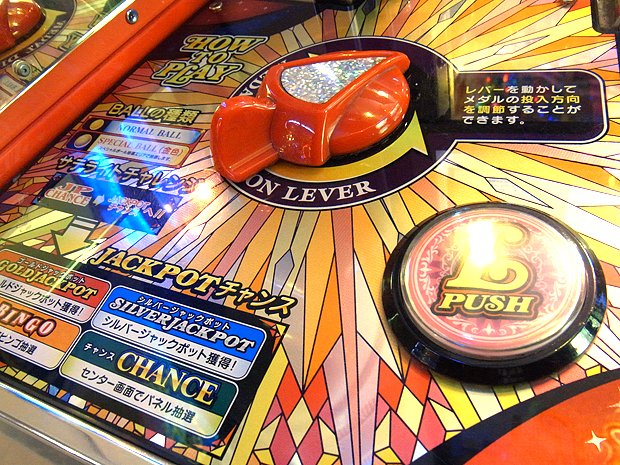Plus Alpha: Feel it in the one drop
Medal games and the changing landscape of Japanese game centers

Plus Alpha is a weekly column that explores life in Japan from the perspective of American expatriate and game-industry veteran Jarik Sikat. Having worked in numerous areas of the game industry since 1994, Sikat relocated to Japan in 2010.
Coming to Tokyo as a visitor, whenever I’ve wandered into the arcades (more often referred to as “game centers”), I’ve always been focused on traditional videogames. Especially back in the ‘90s, when games like Jambo! Safari, Silent Scope, Tokyo Wars and Konami’s Bemani music games were released with overwhelming frequency. While those types of games still exist, it often seems that games based on some cool gimmick – like 2010’s Metal Gear Solid Arcade 3D, with its headset controllers – trickle out much less often. The few games that do hit arcades, such as Sega’s mech-based shooter Border Break, more closely resemble PC and console games. Further, the attract modes on some games are now used to show ads for completely unrelated Wii titles.

These days, videogames have given way to crane games, photo booths and medal games. Now, with the first two, I could immediately understand the appeal: In a crane game (or “UFO Catcher”), there’s the potential to win pretty cool prizes, and one could easily argue that some degree of skill is involved. And the purikura photo booths largely appeal to girls and couples. But what I couldn’t grasp was the ever-increasing square footage being given to medal games, specifically coin pushers.
None of the games use real coins. Instead, each game center requires you to purchase tokens or medals to play, but it’s not like you can win tickets to trade in for prizes, or somehow exchange your medals for a fistful of yen in an elaborate scheme resembling those used by Japan’s ubiquitous pachinko parlors.
“So what’s the point?” I asked a good friend. It’s about winning time; time to simply play the game longer, and simply be out of the house and entertained. It’s a cheap date. To put it in perspective, a regular-priced movie admission for two in Tokyo will set you back 3600 yen (about US$50). 300 medals could run you as little as 1000 yen, depending on the game center. Medals can even be saved for later play in the game center’s biometric ID-protected “medal banks.”

Medals are dropped into the machines through a slot or rail that can be aimed at various points along a platform, where mechanical pushers move the coins forward either to a lower plateau or drop out of the machine, rewarding the player. But these modern Japanese medal pushers include entire worlds and backstories. Not only are medals dropped, but there are also jewels and other items that trigger bonus video slot machines with progressive jackpots, roulette wheels and minigames featuring Donkey Kong and Mario.
Finally giving in to the experience, I was taken to a game center in Yokohama where Konami’s Grand Cross Chronicle was waiting to make me its slave. Now these aren’t the old school carnie-run quarter pushers you’d find back home. Grand Cross Chronicle is a palatial structure accommodating up to 32 simultaneous players. It’s a circus of flashing multicolored lights, disco balls, stained glass, and huge HD video screens. At its core, a nearly vertical mounted roulette wheel spinning on two axes is so massive it uses a 16-inch ball.
Sign up to the GamesRadar+ Newsletter
Weekly digests, tales from the communities you love, and more
Elvis isn’t dead. He lives in Japan and designs game cabinets.

Mounted on the cushioned seatbacks are rear speakers, so when you’re deluged with a jackpot and hundreds of medals come raining down, Handel’s “Messiah” plays, and you feel completely enveloped by the chorus singing “Hallelujah.” The game’s story has you traversing five different worlds in search of treasure with a steampunk version of the cast of the Wizard of Oz. 1000 yen and two hours later, my turn to the dark side was complete.
Over at Sega’s Galileo Factory, medals aren’t dropped into the machine. Instead, they’re loaded into tubs resembling gun barrels. Two Gatling gun-type hand cranks fire the medals into the machine. Inside, a complex, rollercoaster-like system of bonus ball tubes and rails network throughout the huge 20-player cabinet, while a train circling the machine core is ready to dump its payload of coins on bonus winners. It’s a sight that has to be seen to be believed.
After Japanese class, I’ll fit in a round of Konami’s Jubeat rhythm game, but eventually find myself parked in front of a medal pusher. On this day, to the left of me was an old couple, and on the right a twentysomething mom with a baby stroller. It was then that I asked myself: “Has the landscape of modern Japanese game centers completely changed, or have I?”
Jarik Sikat has worked in the videogame industry in areas ranging from localization and product development to public relations and marketing. As a freelance journalist and writer, his work has appeared in PlayStation: The Official Magazine, Official Xbox Magazine and Newtype USA.



